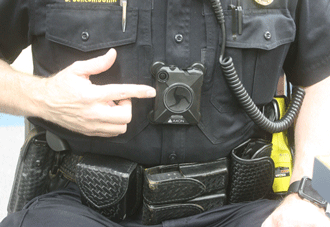May 1, 2020 at 2:03 p.m.
First year of Lakes Area Police bodycams gets positive reviews
As the Chief now for the Lakes Area Police Department, Schlumbohm had only a little discomfort about the agency entering into the world of bodyworn cameras. As we hit the one year anniversary of Lakes Area Police and their bodycam program-- the chief reports no regrets.
Lakes Area initiated its body-cam program in April 2019 and it’s still the lone local agency using bodyworn video/audio recording technology.
Others are on the verge though.
Sheriff Brandon Thyen wants to put bodyworn cameras into use yet this year. By email he tells the Press he’s had this as a priority and allocated funding in this year’s sheriff’s budget for body-cams. But, Covid-19 has cast its shadow on this, just like everything else. The pandemic diverted sheriff’s department administrative attention to maintaining safety for county jail staff and inmates, drafting new policy on how to respond to emergencies, and then recreating systems for holding, assessing and processing offenders to avoid Covid-19 exposure. Someday things will go back to routine-- but implementing bodyworn cameras takes time in policy development and public input has to be solicited.
Sheriff Thyen wants to have patrol equipped initially, and later, get bodyworn cameras into the jail facility as well. Sheriff squads, he pointed out, are currently equipped with vehicle mounted camera recording devices.
“We hope to continue to move forward with the program and take public comments by the end of summer,” the sheriff added.
The bodyworn camera initiative did take time when Lakes Area set on the patch. The Police Commission reviewed policy guidelines put out by the state, adjusted things for the local department’s experiences and the data storage issues worked themselves out with the special equipment system Schlumbohm landed. He says the department has in general is storing 10 gigabytes of data per day, from video files alone. “If it were not for the ability to store the data in the cloud through our vendor I doubt we’d have the capacity to do it. Each traffic stop results in three video streams per officer-- body camera, dash camera and rear seat camera.”
Chief Schlumbohm says the department has seen a nice benefit in being able to use the tape footage to resolve citizen complaints in at least two instances. Persons making a complaint about a Lakes Area officer withdrew after the bodyworn camera footage was reviewed. “The ability to document offender behavior during interactions with officers has been invaluable,” said Chief Schlumbohm.
In North Branch, Police Chief Dan Meyer says right before the coronavirus stay at home order hit, North Branch P.D. was looking into bodyworn cameras. Chief Meyer held conference calls with camera system vendors, and “Once we get back to normal I hope to continue looking at the project.”
North Branch Police had a goal of 2021 for the system, but Chief Meyer said that’s dependent now on how long-- and depth of impact-- this virus situation has on the citizens, staff and finances.
Wyoming Chief of Police and Public Safety Director Paul Hoppe tells the Press by email, that bodycams are at the top of his programming initiatives, and he’d want to have them mandatory for all officers. “It still has to make it through the budget process,” he cautioned.
As for Lakes Area Officers themselves-- Chief Schlumbohm reports the officers are “universally embracing” the cameras. “The biggest hangup has been developing the muscle memory to activate the cameras in the heat of the moment...(should) something suddenly happen,” he said.
The devices used by Lakes Area Police are wirelessly synchronized to turn on automatically when lights/sirens are activated so emergencies and traffic stops don’t involve turning cameras on or off.
Chief Schlumbohm said some of the footage has been used in trainings to demonstrate the correct way to handle a real life situation.
There is an email link to prosecutors and other law enforcement agencies that’s also a new useful tool. The sharing includes safeguards so the department can blur images of juveniles, innocent bystanders, etc. whose images should not be made public. The people who access the data are also identified and a record maintained.
Chief Schlumbohm is already considering the next wave of technology. It would be useful for the department to monitor remote cameras live and the system has the potential to add a trigger so that bodycams are automatically activated if a TASER is turned on.




Comments:
Commenting has been disabled for this item.